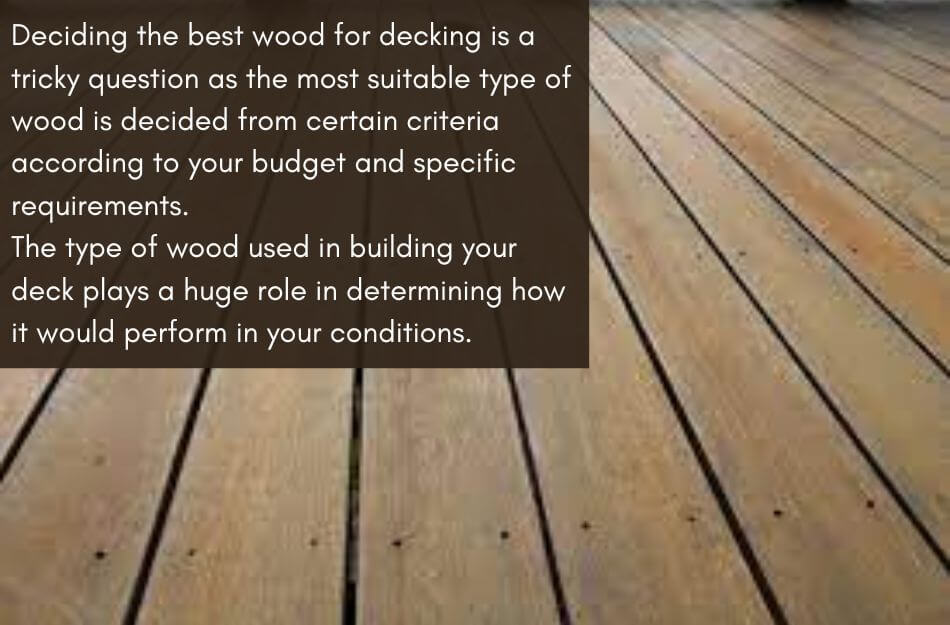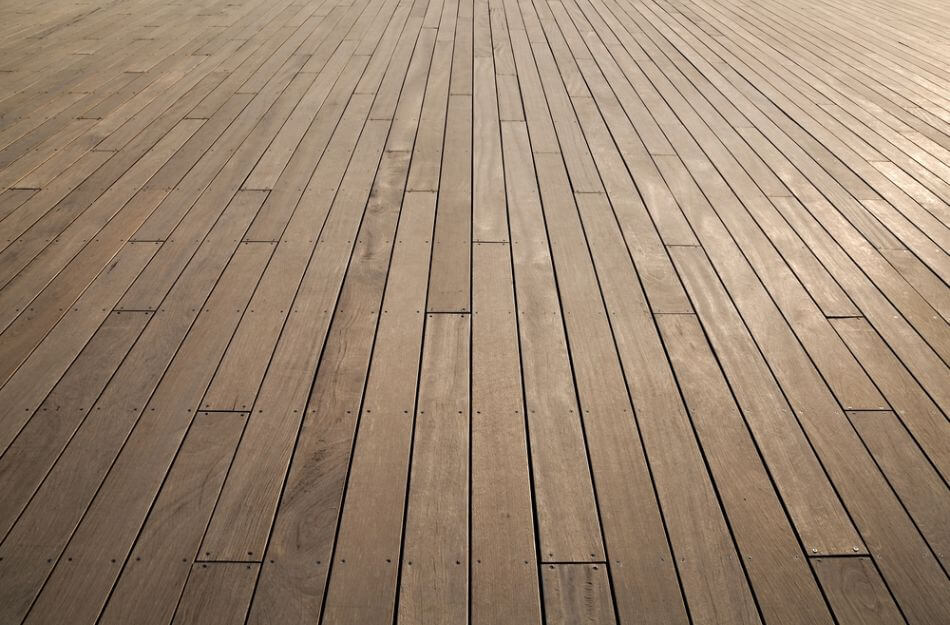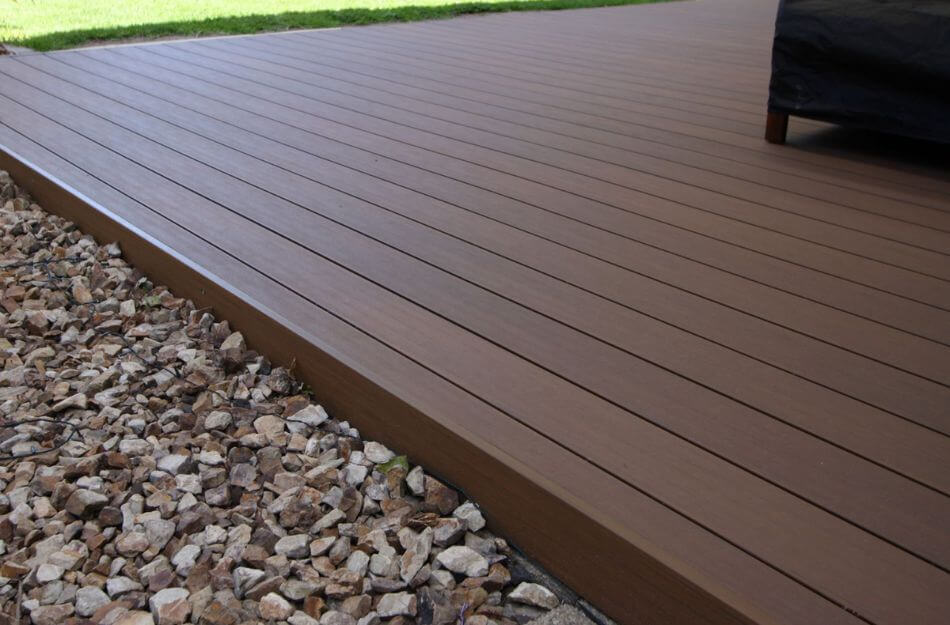People who want to build a deck often need clarification regarding the type of wood they should choose.
With a wide variety of wood available in the market, such as different types of hardwood, and composite wood, it is fair that you might get double-minded while choosing.
Deciding the best wood for decking is a tricky question as the most suitable type of wood is decided from certain criteria according to your budget and specific requirements.
The type of wood used in building your deck plays a huge role in determining how it would perform in your conditions.
Different types of wood will have different results, so make sure you know your wood’s type and quality. Here are a few factors you should look for in wood:

- Sturdiness
- Weather-resistance
- Non-fading color
- Scratchless surface
Table of Contents
Wood Types
There are several wood types that you can choose from. Select your wood type smartly, as it can affect your overall and future maintenance costs.
Natural Softwood
Softwood is not a good idea if you want your deck to be strong and long-lasting. Softwood does not have the level of strength and resistance against moisture, weather conditions, or infestation.
Although it would be the cheapest option, it will only last a while. However, if you are willing to spend some money to secure it through sealing or staining, you might have a decent chance of the wood lasting for some time.
Here are some options you can consider in softwood:
- Pine: Pine is relatively cost-effective, and if preserved correctly, it can be worth your buck.
- Cedar: This is a bit more expensive than pine but offers greater resistance against moisture and is more durable.
- Redwood: Coming in at the highest rates, redwood offers the greatest strength in softwoods and the most durability.
Natural Hardwood
Depending on which hardwood you choose, it can be quite reasonable and give value to your money. Hardwood is more robust and exhibits greater strength.

Besides, if you use it with stainers or sealant, you will have a sturdy deck in no time.
However, as hardwood trees are slow-growing, they are less abundant than softwoods and are quite expensive. Below are some hardwoods you should consider for your decking:
- Oak: The most affordable hardwood option provides decent robustness and moisture resistance.
- Teak: Teak is famous for its insect and infestation-repellent qualities. This is mainly because of the high oil quantity, making it super moisture-resistant. Although it is expensive, it provides appropriate value for your money.
- Ipe: This is the most popular among hardwoods and the most expensive. It is quite rare as South America is its sole native region and has already been over-harvested. However, it provides extreme resistance against moisture, weather conditions, and scratches and is the most suitable hardwood for your deck.
Composite Woods
Composite woods are treated types passed through various chemical treatments that are not entirely natural. Composite woods are a mixture of wood, plastic, PVC, and other materials.
They exhibit greater resistance against strong weather conditions and are more robust than normal wood types. However, as functional as they are, they are also very costly.
Composite wood is not natural and is made for various purposes, such as strength and anti-decaying properties, mainly because it contains other composite materials, such as plastic and PVC.
Although it is the most expensive, it is also the most durable and reliable wood you can have for your deck. The maintenance cost of composite wood is extremely low, which makes it a suitable option for long-term use.
See Also: Best Decking Material For Winter: Find Your Best Option
- Pressure Treated Lumber
This type of wood is treated with pressure to make it robust and resistant to the actions of wind and rain. It offers optimal durability and resistance against moisture and can hold decent weights.
The optimum time is around 6 months; however, it is best to test the wood for moisture before painting it.
2. Green Lumber
Green lumber is a specially treated wood that is highly effective against pest attacks, rotting, and similar issues normal wood faces. However, it is separate from green wood, a term used for freshly cut wood.
Green lumber is not the most suitable type of wood for building decks as it can crack and warp once it starts to dry, but still, many people use it mainly because of its abundance.
Green lumber needs at least 1 year before you can start painting it. However, you can remove the gray color by scrubbing and power washing.
3. Kiln-dried Lumber
This is the most common type of lumber available in stores because it is pre-dried to a certain extent.
This allows more resistance against moisture; besides, kiln-dried lumber is very strong and doesn’t come very costly.
Hence, making it a fast and suitable option for your deck-building requirements. This type’s optimum dry time is around two to three months.
Kind-dried lumber will have a sign of KDAT ( Kiln Dried After Treatment) on the wood to indicate that it has been dried to some extent.
Related: Deck Landscaping Ideas With Rocks: Creative Outdoor Space
Other Factors To Consider

Climate
The climate of the area and the current weather are also major factors in determining what type of wood will suit.
If you live in a colder environment, you might experience cracks and dryness in your wood if it is not robust enough to cope with weather conditions, and snow might also damage the wood surface.
Besides, if temperature levels are higher, there would be greater moisture. Your untreated wood might not be best suited for it.
In addition, if you live in a rainy climate, constant exposure to water can damage the surface of the wood. Water may pool on your deck and cause the wooden boards to swell and chip.
Select The Right Time of The Year
Consider the right time to start your project according to the time the wood needs to dry up.
If you start in summer, you have the edge of temperature and the sunlight to allow the moisture of your wooden boards to dry up and the chemicals to set in.
However, if you start in winter, you might face some problems initially, but by the time summer or spring arrive, your deck will be ready to use.
How To Preserve Wood

Sealants
- UV & Fade Resistant: UV and fade-resistant wood sealers work excellently to save the color and shine of your deck and ensure that it always looks lush despite being exposed to sunlight half of the day.
Prolonged exposure to UV rays can cause the wooden planks to dry up and lose all the necessary moisture inside them. This might make your boards stiffer than normal and prone to breaking.
- Waterproof: Waterproof wood sealers are extremely important in the rainy season. Excessive water landing on your deck can create serious problems. Firstly, the water can get stuck in the expansion room you have left for the boards, which will disable expansion and weaken the structure.
Secondly, the water can seep into the wood through the pores and cause it to swell up. This would mean that the wood has lost its strength completely and become a spongy compound that will wither very soon.
Lastly, if the water freezes in either the expansion room or inside the boards, it can cause them to break almost immediately, and your deck will be destroyed in a matter of days.
Staining
Stains are pigmented substances that protect against harsh UV rays and resist moisture.
If you want a better color and protection on your deck, you can try staining but do keep in mind that it doesn’t provide as much protection as sealants from moisture.
So, if you live in an area where humidity is high, or it is a tropical zone, you should reconsider your decision.
- Water-based stains: These types of stains are commonly used for furniture and fences but can also be used on decks. It does a great job in protection, can be applied in low temperatures, and dries up quickly. Besides, it is best recommended for rot and decay-resistant woods.
- Oil-based stains: These are highly functional as they are proposed to move into the pores of the wooden surface and form a protective layer. Although they are harder to apply than water-based stains, you will find them much more shiny and natural once they have been applied.
- Hybrid stains: These stains are a mixture of alkyd and acrylic stains and are much easier to apply than oil-based stains. Besides, they yield similar results as both stains above and are hence considered the best choice by some users.
Painting

Painting is yet another suitable alternative to protect your deck.
Choose a paint of your preference and apply it according to the instructions. Make sure you apply the right amount, as a very thick or thin layer might yield different results.
Once you have successfully applied the paint on the entire surface, let it dry and lock it into the wood, and you’re good to go.
Final Thoughts
Selecting the right type of wood is very important if you want your deck to have practical longevity, extreme strength, and robustness, even in harsh times.
Hence, follow our guide and select the most appropriate type of wood according to your budget and requirements.
Recent Posts
Although deck sealing may not be at the top of your summer to-do list, you shouldn’t put off a task.One such deck that channels the opposite of the lively and enjoyable vibe you want from an...
Any home would benefit from having a deck because it adds more area for socializing, relaxing, and outside activities.Garden decking that has been properly polished can be elegant and lovely. It...
